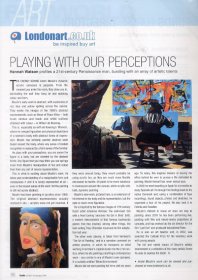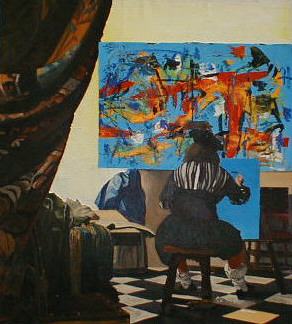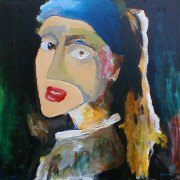|
Kunstanmeldelse af
Hannah Watson, LondonArt
i Funds Europe juli/aug 2004
PLAYING WITH OUR
PERCEPTIONS
Hannah Watson profiles a 21st-century Renaissance man, bursting with an array of artistic talents
The energy behind André Moulinīs dynamic acrylic canvases is palpable. From the moment you enter the room, they draw you in, domnating the wall they hang on and radiating colour and form.
Moulinīs early work is abstract, with explosions of red, blue and yellow spilling across the canvas. They evoke the images of the 1950īs abstract expressionists, such as those of Franz Kline - bold brush strokes and black and white outlines attacked with colour - or Wilhelm de Kooning.
This is especially so with de Kooningīs "Women", where he emerged figurative and psysical depictions of a womansīs body with abstract forms of expression. Moulin has similarly painted abstract work based around the body, where any sense of instant recognition is replaced by a faint sense of the familiar. He plays with our perceptions: you are aware the figure is a body, but are diverted by the abstract forms. Any figure that you may think you see springs more from Moulin`s manipulation of line and colour than from any sort of natural representation.
This is what is exciting about Moulinīs work. He takes your understanding of a recognisable form and manipulates it until it is barely represented at all - even in the loosest sense of the word. Yet the painting is still not purely abstract.
Moulin has been painting in acrylics since 1989. The original abstract expressionists actually worked in oils - acrylics were not yet invented. If they were around today, they would probably be using acrylic too, as the are much more flexible and easier to handle. Oil paint is far more laborious to manoeuvre around the canvas, while acrylic aids bold, dynamic painting.
Moulinīs new work, pictured here, is an extension of his interest in the body and its representation, but the style is much more figurative.
He is inspired by the famous images of the 17th century Dutch artist Johannes Vermeer. The well-loved "Girl with a Pearl Earring" becomes "No Girl in Mind": a modern interpretation of that famous backwards glance that has inspired, among other things, the best-selling Tracy Chevalier novel its film adaption last year.
The other work, is taken from Vermeerīs "The Art of Painting", and is a narrative comment on artistic practice, in which he transports an artist working in Vermeerīs original studio into the 21st century, where he sits painting a startlingly contemporary work - very similar to one of Moulinīs own canvases. It is suitably entitled "Mixed Environment".
Moulin did not start painting full-time until six years ago. To many, this inspires dreams of leaving the office behind for ever to pursue a life dedicated to painting; Moulin himself has never looked back.
In 2000 he went travelling in Spain for six months to study Spanish art. He brought his findings back to his native Denmark and, using a combination of tape recordings, found objects, photos and sketches, he organised a tour of his project. He also took it to Estonia and Sweden.
Moulinīs interest in visual art does not stop at painting: since 2001 he has been performing live, painting with film and mixed-media projectors at concerts, and has worked as the art director for the film "Last Exit" and produced educational films.
He is also an art teacher and, in 2002, was awarded th Cultural Prize for his voluntary work with young people.
The full and varied nature of Moulinīs artistic involvement is a reflection of the may artistic forms he used to express his talent. André Moulinīs work can be viewed and purchased at
www.londonart.co.uk
|


Mixed Environment

No Girl in Mind
|
